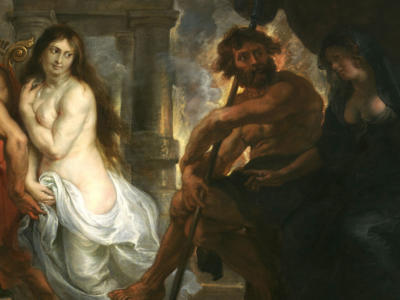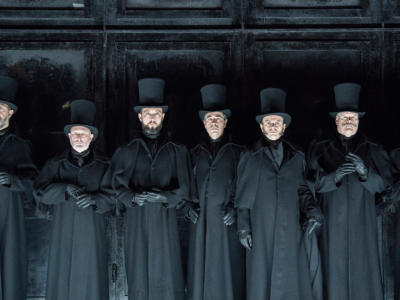Opera's greatest love stories
For the last 400 years, operas have been based around themes of real human emotion: life, death, joy, anger, and most predominantly, love. From two impoverished bohemians, to lovers who can only be together in death, we’ve chosen some of opera’s greatest love stories.
Mimì and Rodolfo – La bohème
Video
Puccini’s classic tear-jerker, La bohème, features one of operas most-loved and best-known love stories. When seamstress Mimì knocks on poet Rodolfo’s door, they fall in love almost instantly. The two poverty-stricken lovers enjoy a whirlwind romance until Rodolfo suspects Mimì is secretly battling a deadly illness. In a desperate bid to push Mimì towards a richer suitor (who can pay for her treatment), Rodolfo rejects his love, and the pair go their separate ways.
As with all great opera tragedies, the couple reignite their flame, although Mimi’s illness has already taken over her, and she dies in her lover’s arms. Puccini’s opera is based on Henri Murger’s novel, Scenes from Bohemian life (Scènes de la vie de bohème). This semi-autobiographical work was heavily inspired by Murger’s own experiences as an impoverished Parisian.
Alfredo and Violetta – La traviata
Video
Another classic tragedy, Verdi’s La traviata, follows the love story of courtesan Violetta, and her admirer, Alfredo. When Alfredo tries to convince Violetta to leave her fast-paced life behind for a quiet and secure life with him, she mocks him, unsure why he would ever be in love with her. Eventually, Alfredo convinces Violetta that he is serious, and she agrees to move to the country and leave her life behind in the hopes of finding true love. Whilst enjoying their new lives together, Alfredo’s father pays Violetta a visit, and convinces her to leave Alfredo, as their love is threatening his daughters impending marriage. It isn’t until Violetta is on her deathbed that Alfredo learns the truth behind her leaving. He returns to her, but unfortunately it’s too late.
Verdi’s La traviata is based on The Lady of the Camellias, Alexandre Dumas’s novel, inspired by an affair he had with Parisian courtesan Marie Duplessis. La traviata’s depiction of Violetta’s tragic life was a common theme in nineteenth century art and literature.
Hanna and Danilo – The Merry Widow
Video
Franz Lehár’s operetta The Merry Widow (Die lustige Witwe) tells the story of recently widowed, Hanna Glawari and the men who wish to marry her for her fortune. One of Hanna’s suitors, Count Danilo, has history with Hanna, but declares he will never marry her. It’s not until Baron Zeta, announces his divorce from his wife and proposes to Hanna, that she reveals she will in fact lose her fortune if she remarries. Upon this announcement all the men lose interest, except Danilo, who declares he can finally marry Hanna.
The Theatre an der Wien’s director in 1905 was so convinced The Merry Widow would be a failure, he offered Lehár five thousand crowns to withdraw it. After a slow start, the operetta began to break records and to this day is one of the most performed operettas.
Aida and Radames – Aida
Video
Torn between the duty to her country and her devotion to the man she loves, Aida is Verdi’s tale of ultimate sacrifice. Aida, the Ethiopian slave of the Egyptian Princess, Amneris, and General Radames are secretly in love with one another. When the Ethiopian army is defeated during a war led by Radames, Aida’s father King Amonasro is captured, but signals to his daughter to keep his identity a secret. Convinced by her father to align her loyalties to her country, Aida tricks Radames into revealing the tactics of the Egyptian Army. Radames and Aida’s affair is discovered by Amneris, and the pair are separated. Radames is being tried as a traitor to his country, and believes Aida to be dead. The disgraced general is condemned to be buried alive. Once placed in his eternal tomb, Radames finds Aida also in there, so the lovers shall die together.
Verdi initially turned down Egyptian Ruler Khedive Isma’il Pasha’s proposition to write an inaugural hymn for the opening of his new opera house. One year later he agreed to compose a brand new opera, instead. Although Aida wasn’t ready in time for the opening of the Cairo Opera House, it premiered there, and has since become a central part of the operatic cannon.
Tristan and Isolde - Tristan and Isolde
Video
Wagner’s four-hour-long opera is all about impossible love. Irish Princess Isolde is on her way to marry King Marke of Cornwall, chaperoned by Tristan, the King’s nephew. Isolde is angry with the way Tristan is treating her, and commands her maid to create a potion that would bring death to them both. The maid, Brangäne, instead makes a love potion, and upon drinking it, both Tristan and Isolde fall in love. The betrayed King soon discovers the pair are in love, and Tristan ends up being attacked by one of the King’s knights. Back at his castle, the mortally wounded Tristan is waiting for Isolde to return to him. In frustration, he tears off his bandages, letting his wounds bleed. At this moment, Isolde rushes in, but it’s too late and Tristan dies in her arms. Overcome with grief, and wrongfully assuming the King Marke is on his way to exact revenge, Isolde too dies.
Personal suffering from love was the inspiration behind this tragic piece. At the time, Wagner was having an affair with German poet, Mathilde Wesendonck, the wife of one of his wealthy patrons. The love triangle that ensued, between him, his wife and Mathilde spurred him to write the tale of the two lovers who could never be together.


